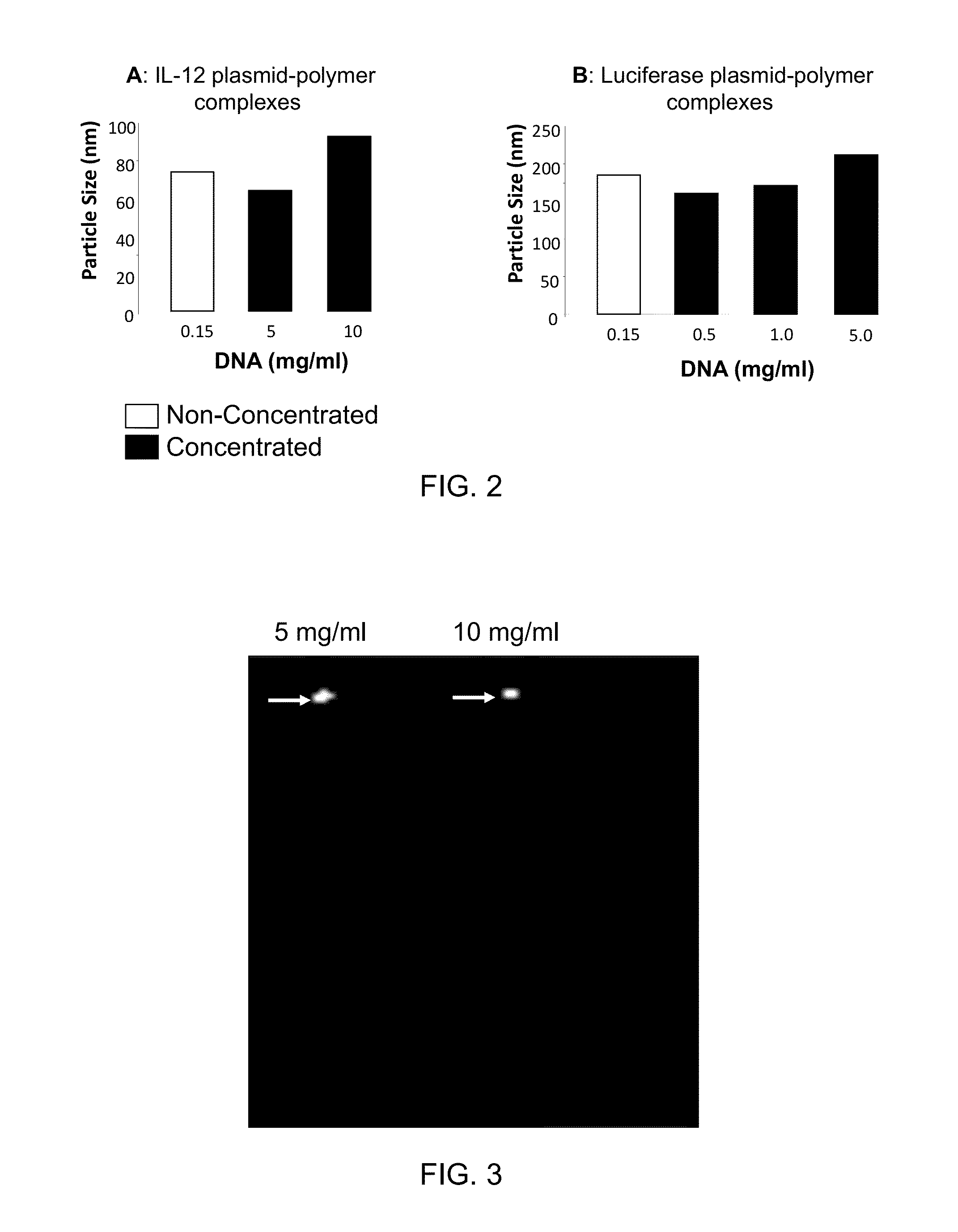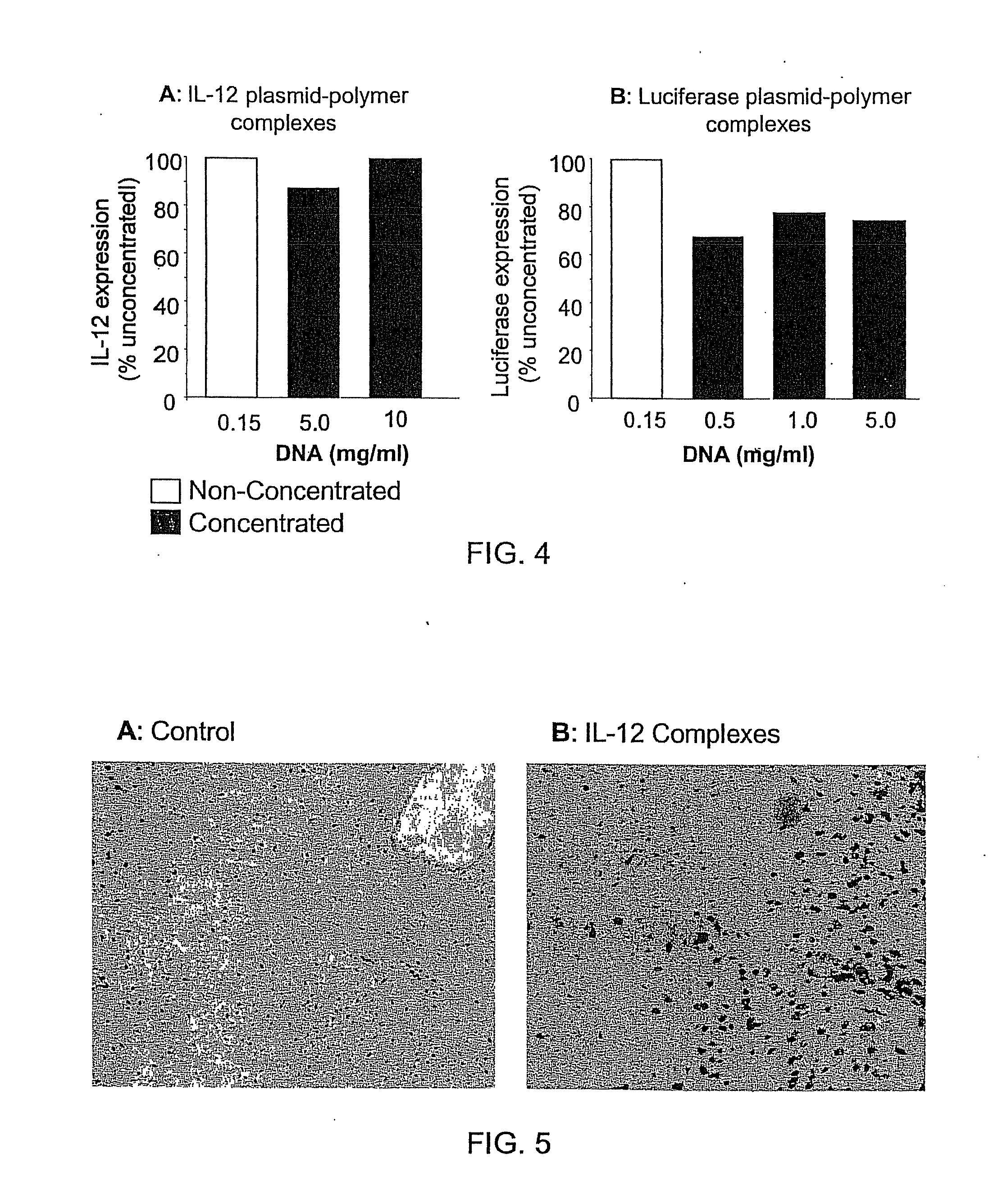Nucleic Acid-Lipopolymer Compositions
a technology applied in the field of concentrated and stable formulations of nucleic acid and lipopolymer, can solve the problems of formulation stability, scale up, low efficiency of synthetic vector transfection, etc., and achieve the effect of reducing the efficiency and dosing flexibility of nucleic acid transfection and efficiently being lyophilized
- Summary
- Abstract
- Description
- Claims
- Application Information
AI Technical Summary
Benefits of technology
Problems solved by technology
Method used
Image
Examples
example 1
Preparation of Concentrated Liquid Formulations of Condensed Nucleic Acid with a Cationic Lipopolymer
[0087]This example illustrates preparation of highly concentrated formulations of fully condensed nucleic acid at bench-scale production. This involves preparation of nucleic acid complexes with a cationic polymer followed by lyophilization and reconstitution to isotonic solutions. The nucleic acid used is a plasmid DNA encoding for IL-12 or luciferase gene, and the polymer comprised a polyethylenimine (PEI) backbone covalently linked to polyethylene glycol (PEG) and cholesterol (Chol) (PEG-PEI-Chol or PPC). The molar ratio between PEG and PEI and between cholesterol and PEI is 0.5-10 and 0.1-10, respectively. First, the DNA and PPC solutions are separately prepared at 5 mg / ml in water for injection and subsequently diluted to 0.15 mg / ml (DNA) and 0.554 mg / ml (PPC) at 3% lactose. The DNA in lactose solution is added to the PPC in lactose solution using a micropipette to a nitrogen to...
example 1a
[0093]A nucleic acid / cationic lipopolymer formulation is prepared essentially according to the procedure outlined above in Example 1 using a cationic lipopolymer and IL-12 nucleic acid at an N:P ratio of 11:1. The cationic lipopolymer has a PEG:PEI:Cholesterol molar ratio of about 2.5:1:0.6, and a molecular weight (as the free base) of about 3.54 kD. The resulting formulation containing lactose is lyophilized and can be reconstituted to nucleic acid concentrations of at least about 0.5 mg / ml without agglomeration of the nucleic acid or loss of significant transfection activity.
example 2
Preparation of Concentrated Liquid Formulations of Condensed Nucleic Acid with a Cationic Lipopolymer
[0094]This example illustrates a preparation of highly concentrated formulations of condensed nucleic acid, as is shown in FIG. 1. This protocol has produced over 6000 mg of fully formulated DNA (as compared to 100-200 mg DNA produced from the small-scale preparation described in Example 1) and can be expanded to even higher production amounts. The scaled-up method involved mixing of the bulk DNA and polymer solutions with a peristaltic pump achieving an online mixing scenario to form the complexes followed by freeze-drying cycles compatible for large load. Briefly, the DNA and PPC solutions are prepared at 0.3 mg / ml and 1.1 mg / ml in 3% lactose, respectively. The two components are combined at a constant flow rate using a peristaltic pump (WATSON MARLOW, SCI 400) with a 0.89 mm internal diameter of silicon tubing (WATSON MARLOW, Z982-0088) at a flow rate of 225±25 ml / min. The two mix...
PUM
| Property | Measurement | Unit |
|---|---|---|
| molar ratio | aaaaa | aaaaa |
| molar ratio | aaaaa | aaaaa |
| concentration | aaaaa | aaaaa |
Abstract
Description
Claims
Application Information
 Login to View More
Login to View More - R&D
- Intellectual Property
- Life Sciences
- Materials
- Tech Scout
- Unparalleled Data Quality
- Higher Quality Content
- 60% Fewer Hallucinations
Browse by: Latest US Patents, China's latest patents, Technical Efficacy Thesaurus, Application Domain, Technology Topic, Popular Technical Reports.
© 2025 PatSnap. All rights reserved.Legal|Privacy policy|Modern Slavery Act Transparency Statement|Sitemap|About US| Contact US: help@patsnap.com



